Do Breasts Really Sag after Breastfeeding?
Lately, we’ve been receiving a lot of questions on whether breastfeeding causes women’s breasts to start sagging.
The general answer is this: it’s not the breastfeeding that’s causing the sagging, but pregnancy overall.
During pregnancy, a woman’s body undergoes a number of major changes, and so do the breasts. Many of these changes stretch out the breasts’ skin and ligaments, causing them to start sagging.
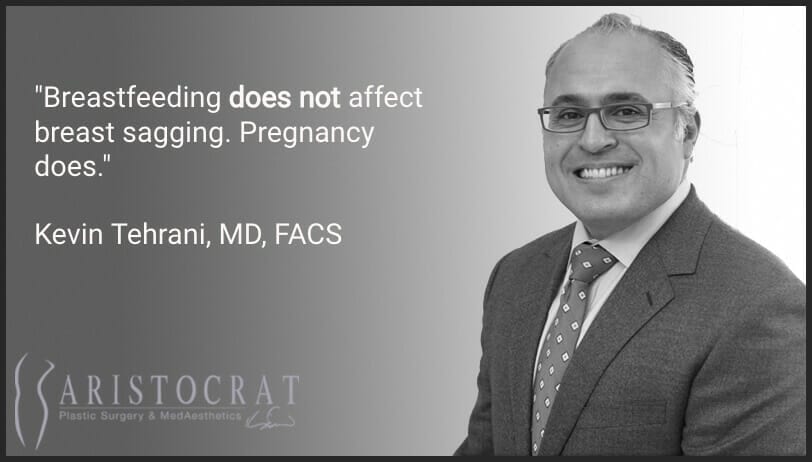
There are many other reasons why your breasts may appear less firm after childbirth:
- High body mass index
- Smoking
- Several back-to-back pregnancies
- Large pre-pregnancy bra size
Women’s breasts do not contain any muscle and they are only attached to the muscles in the chest via some thin bands, called the Cooper’s ligaments. These bands can easily be stretched, and that is the reason why the breasts are soft and can easily move around.
During pregnancy, the breasts will go through several changes and they may get bigger as your body prepares for breastfeeding.
Days after the arrival of the baby, the breasts may become heavier and fuller. This is majorly caused by the increase in blood supply to the breasts.
As the breasts become bigger, the ligaments, which give them support, may start to stretch and it is this stretching that leads to saggy breasts.
How Does Pregnancy Change a Woman’s Body?
There is no doubt; giving birth to a new baby is a beautiful thing and also a challenge that is difficult to compare to anything else. An unforgiving, yet most rewarding endeavour that nursing mothers just have to deal with.
Besides the joy of bringing a new life into this world, pregnancy and giving birth takes a huge toll on the woman, both emotional and physical.
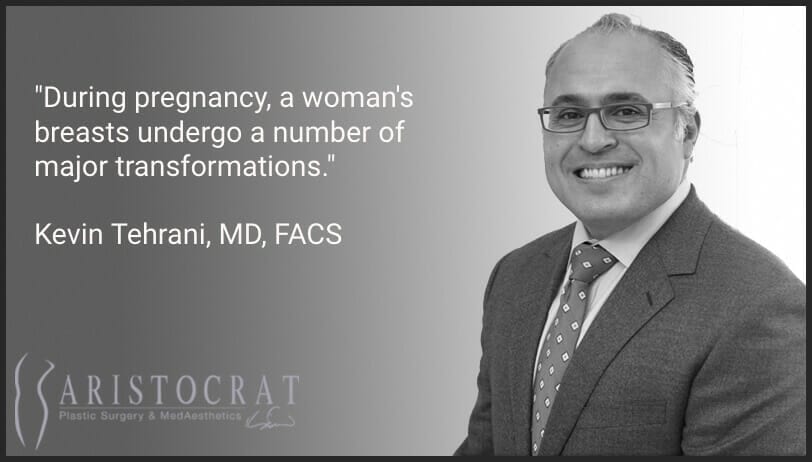
Apart from the entire baby-growing period and its pleasantries, hairs will begin to sprout in weird places, skin will begin to stretch in areas that you never thought would ever be affected; breasts will begin to increase in shape and size.
While these sorts of changes can be temporary, pregnancy can also cause the body to change in permanent ways.
Changes To Expect During Pregnancy
Most pregnant women experience never-ending fatigue in the first trimester as their bodies begin to make preparations to host a new life.
- Frequent Urination: During the first trimester, there will be the urge to urinate more frequently. The reason for this is that the growing uterus pushes more onto the bladder. There is even the possibility of leaking a little urine when you sneeze or cough.
- Lightheadedness: Early-to-mid pregnancy, the body will work overtime to provide extra blood to support the baby. You may experience lightheadedness or dizziness, weakness and hunger. These symptoms can be caused by stress as well.
- Heartburn: The muscles responsible for the breakdown of food become more relaxed during pregnancy. Not only that, but hormonal changes will also slow down the digestive process. Food will take a longer time to be processed in the stomach, which may eventually lead to heartburn—a burning sensation in your throat and chest area.
- Constipation: At this stage, you are expected to take a daily supplement that contains iron. While the nutrient is extremely important for pregnant women, it can lead to constipation. The partial shut-down of digestive processes doesn’t help. The doctor may suggest that you take a stool softener or fiber supplement to provide relief. This is one of the reasons why you need to take lots of water at this stage—as many as 8 glasses a day—during pregnancy.
- Visible Veins: Thanks to the baby, your body feels the need to make more blood, which means there’s more blood flowing through your veins at any point in time. This can make the veins in your legs, breasts, and belly to become more visible. Some women may develop spider veins on their arms, neck or face.
- Skin Changes: You may start noticing that your skin looks more shiny and rosy during pregnancy. This is called the Pregnancy Glow by some people. It is caused by an increase in blood circulation. Pregnancy hormones can also cause your skin to secrete more oils.
Breast Changes During Pregnancy
Breast changes are normal during pregnancy and they mostly occur due to hormonal changes in women.
In fact, most women will begin experiencing changes in their breasts during the 1st week of conception, and this can continue until the child is delivered and even after delivery.
We will highlight a few common changes that you can experience during pregnancy. Is important to understand that this is a generalization, and each woman will go through pregnancy differently.
1st Trimester Breast Changes
- Tenderness and Discomfort: Tenderness in the breasts is one of the earliest symptoms that a woman will notice when she gets pregnant. According to a report by the National Institute of Child Health and Human Development, a woman may develop sore, tingly or heavy breasts within the 1st and 2nd weeks of pregnancy. She may even experience painfulness in the nipples.
The rising level of hormones in the body is responsible for these changes as well as the increase of blood flow to the breast tissue. The discomfort may recede after one week, although it may persist up until the very last stages of pregnancy.
- Enlargement: The breast will go up a cup size or two, especially for new moms. This can be experienced early into the pregnancy and then continue throughout the period. Usually, the breasts reach their peak size just before childbirth—to prepare for breastfeeding.
2nd Trimester Changes
- Darker Areolas: The colored circle around a woman’s nipples is called the areola. During the 2nd and 3rd trimesters, they tend to get larger and darker.
- Areola bumps: There will also be small bumps on the areolas at this stage. These bumps produce oils and they are responsible for the lubrication of the breasts to promote easier breastfeeding. The bumps are usually painless.
- Nipple Discharge: During the 2nd trimester, some women may also notice nipple discharge and this will only appear in some women at the 3rd trimester or even after labor.
- Lumps in the Breast: Some women unexpectedly discover lumps in their breasts while pregnant. The lumps are not anything to be concerned about, although they should be checked out by a doctor.
3rd Trimester Changes
- Continued Growth: Most of the breast changes that are experienced in the 1st and 2nd trimesters will continue into the 3rd trimester. At this stage, the woman can even experience a larger and heavier breasts shaping up. At this stage, the nipples may also continue to darken and the breasts may leak more regularly.
- Stretch marks: The skin will begin to stretch as a result of rapidly growing tissues. This will lead to the development of stretch marks. Studies indicate that 60 to 90% of pregnant women develop stretch marks on their breasts at this stage.
Other Reasons Why Breasts Sag
Medically, breast sagging is called ptosis. These changes occur naturally with age, and they have nothing to do with the pregnancy.
It may be difficult to admit, but the fact remains that some breast sagging is unavoidable as we age. Delivering a baby, breastfeeding, and aging—a number of factors can contribute to the loss of firmness and elasticity of the breasts, accelerating the process.
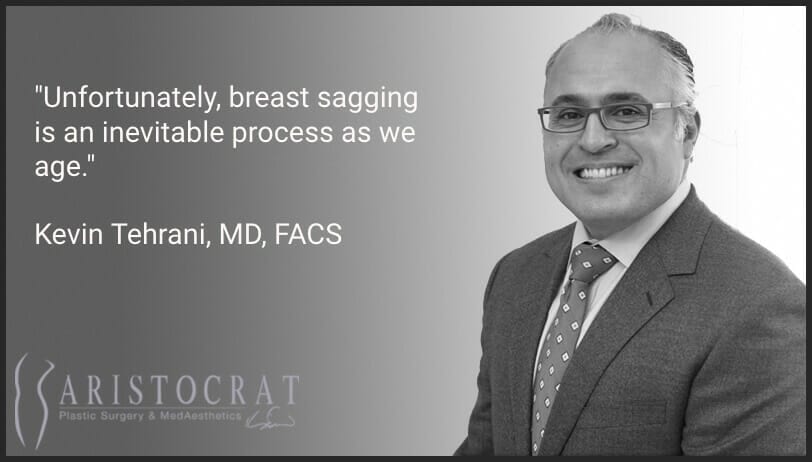
Sagging breasts can also come naturally for some people. It can be a matter of genetics. If a mother had sagging breasts, the daughter might as well be predisposed to it.
Keep in mind that a recent study by UCLA discovered that tissues in the breasts age 2-3 years faster than the other parts of the body.
The Age Breasts Start To Sag
There is no specific age that the breasts can begin to sag. A lady in her twenties could have droopy breasts, while a woman in her forties could still enjoy perky breasts.
Since there are a number of factors that cause sagginess, women may start seeing their breasts give in to gravity at different times of their lives. One thing is unavoidable: all breasts start sagging with sooner or later.
If you are lucky enough to escape sagginess in your thirties and forties, you are very much likely to experience it when your body begins to pass through the hormonal changes that occur due to menopause.
Causes of Breast Sagging
The breasts get their support from the Cooper’s ligaments. With time, they begin to stretch out and make the breasts sag.
Loss of skin elasticity can also cause one’s breasts to become saggy.
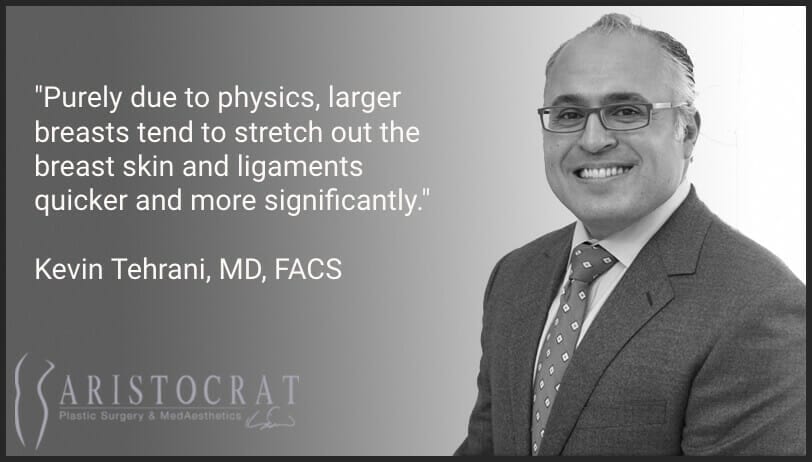
Many factors can influence when you experience these changes and the rate at which they happen. Here are a few common causes of breast sagging:
- Gravity: Gravity works against our breasts every day. So while it may pull your breasts down, it will also stretch and strain the ligaments of the breasts.
- Shape and Size of the Breasts: Women with smaller breasts may not experience much sagging as the ones with larger breasts. Smaller breasts with rounded bottoms are likely to stay firm in position better than bigger breasts.
- Weight: Higher body mass index in women most times means bigger breasts.
- Weight Gain and Loss: Losing or gaining some weight, especially in a narrow time frame, can cause changes to the shape of the woman’s breasts as well as shrinking of the skin around them.
- Smoking: Smokers are likely to develop saggy breasts because smoking causes the skin to lose its elasticity.
- Genetics: The genes and the heredity a woman gets from her family also play a vital part in the shape and size of her breasts, strength of her Cooper’s ligaments and laxity of the skin.
- Rate of Pregnancy: A woman that has given birth several times is more likely to develop droopy breasts than one who has just given birth once.
- Exercise Without Support: When a woman is performing exercises that involve lots of breast movement, she can set a lot of stress on the breast ligament. In a situation where the breasts are big and they do not have enough support, this can lead to the ligament stretching and eventual sagging of the breast.
- Age: All of us grow older everyday, and it is quite unfortunate that sagging is just a normal part of the process, especially for a woman who has gone through menopause.
Does Breastfeeding Cause Sagging?
As against the general myth, breastfeeding does not cause sagging of the breasts. Studies have shown that the changes experienced during pregnancy are the cause of bigger breasts in a breastfeeding woman.
Do not let the fear of breast sagging prevent you from breastfeeding.
A Few Tips to Prevent Sagging
Since there are a lot of factors that may cause a woman’s breasts to sag, it is not possible to prevent it completely. However, some things can be done to keep the breasts from sagging for a longer period:
- Always maintain good posture: When a woman has poor posture, then she is giving gravity the chance to have more pull at her breast. Standing in a good position with the back straight and the shoulders back will give more support to the breasts.
- Healthy Weight: When a woman eats a well-balanced diet and gets little exercise while maintaining her weight, she is not likely to develop saggy breasts.
- Water: Try as much as possible to keep the skin healthy by drinking a lot of water. This will maintain the elasticity of the skin.
- Smoking: Smoking is a leading cause for the reduction of elastin—a hormone responsible for the elasticity of the skin—which can significantly add to the sagging.
- Sun: In just the way through which antioxidants can make the skin stretchy and supple, harmful chemicals known as free radicals can also cause damage to the skin and make the skin develop wrinkles.
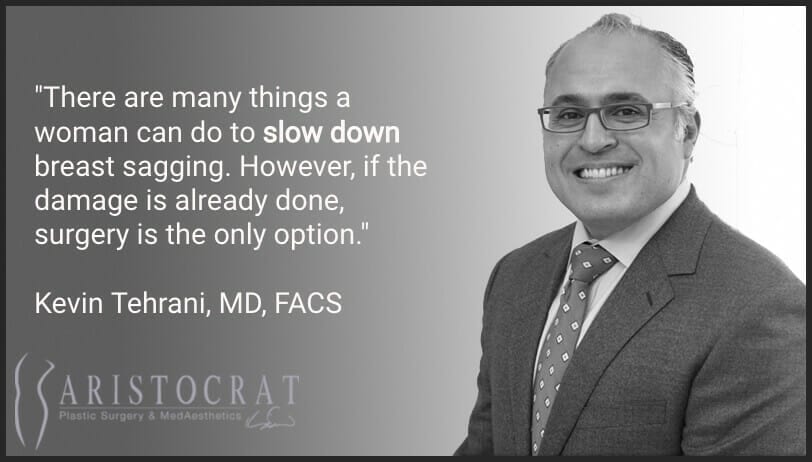
Ultraviolet rays are a source of these free radicals and they can break down the elasticity of the skin. So the more you expose yourself to the sun, the more free radicals you pile up on your skin to cause more damage.
Can Bras Prevent Sagging?
Although there is no study to show if bras can help in the prevention of breasts sagging, many women are of the belief that putting on a supportive and comfortable bra will help in holding up the breasts and maybe keep the ligaments from stretching excessively, most especially if you exercise actively.
Reversing Breast Sagging Naturally
In as much as a saggy breast may not be inevitable, there are some lifestyles a woman could live to help keep the breasts firmer and restore them back to their normal position.
Most women will go for surgery to correct a sagging breast, but this procedure is quite expensive and might not be affordable by many.
Here are a few simple ways through which one can restore a sagging breast naturally:
- Eating healthy
- Exercises: Arm raises, Chest pulls, chest press, push-ups and dumbbell flyes are just a few of the many exercises that you can do to maintain a firmer breast.
- Ice massage
- Regular massage
- Aloe Vera Massage
Breast Lift For Sagging Breasts
A breast lift, which is also referred to as mastopexy, is a procedure done by plastic surgeons to cause changes to restore breast firmness and position. During the procedure, excess skin will be removed from the breast and tissues will be reshaped to raise the breasts.
This procedure can be tried out by women who have sagging breasts or those that have nipples pointing downwards. It is believed by some people that a breast lift will boost their self-confidence and self-image.

